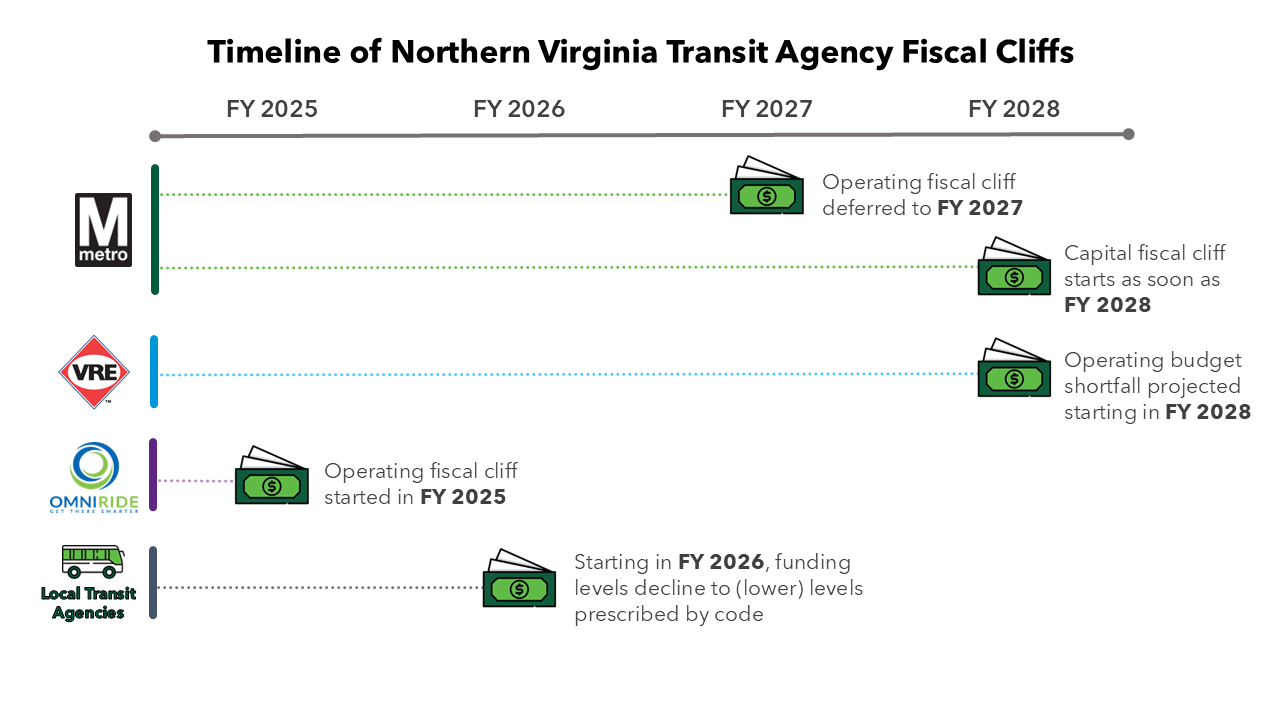Regional conversations are underway regarding sustainable, long-term funding to meet the growing need for public transit in Northern Virginia. NVTC supports efforts to identify long-term sustainable funding solutions and cost-containment strategies to ensure that public transit continues to support the growing needs of Northern Virginia.
On January 16, 2025 the Commission approved the “Guiding Principles for Future Transit Funding,” which calls for continued efforts by Metro, Virginia Railway Express (VRE) and all local public transit systems in Northern Virginia to implement cost containment strategies, generate operational efficiencies and measure progress to ensure an efficient use of taxpayer resources.
This resolution is an opportunity for the Commission to solidify its position on a number of key funding considerations that help to build a Virginia-consensus position that NVTC members of SJ 28, the General Assembly’s Northern Virginia Growing Needs of Public Transit Joint Subcommittee and DMVMoves can use to advocate for NVTC priorities.
For all public transit agencies in Northern Virginia, NVTC seeks a long-term, sustainable, dedicated funding solution for all public transit agencies in Northern Virginia that:
- Provides adequate growth in revenues to meet current and future operating and capital needs for WMATA, VRE and local transit operators in Northern Virginia;
- Preserves existing local, regional and statewide revenue sources that support public transit operating and capital expenses;
- Aims to reduce pressure on property taxes as a funding source for transit;
- Continues to reflect a diverse range of revenue sources to reduce the economic risk associated with overreliance on a single revenue source; and
- Directly distributes revenues to NVTC for allocation to local bus systems, VRE, and to those jurisdictions funding WMATA, matching or similar to NVTC’s financial management model.
As co-owners of VRE, NVTC supports a long-term funding approach for VRE that continues to allocate funds generated from the NVTC and PRTC districts based upon a mutual agreement, and, if used for capital funding, enables their use by VRE for bond debt service.
As the representatives of the Virginia signatories of the WMATA Compact, NVTC supports a long-term funding approach for WMATA that:
- Continues the strong federal commitment to WMATA formula funding as well as the federal dedicated state of good repair funding (PRIIA), ensures those are adjusted for inflation, and explores opportunities for federal operating assistance;
- For non-federal funding, reflects an agreement or framework between Virginia, Maryland and the District of Columbia whereby each identify the revenue solutions that best meet the unique economic and political characteristics of each state level jurisdiction;
- Limits revenues generated in Virginia for WMATA funding purposes to no more than Virginia’s appropriate share of the WMATA budget;
- Continues to demonstrate the shared benefit and shared responsibility of funding WMATA between the NVTC district localities and the Commonwealth, whereby at least 50% of Virginia’s funding for WMATA operations and capital is provided by statewide revenue sources;
- Ensures any regionally-generated revenue sources are raised in a consistent manner across the NVTC District;
- Allows for the establishment by the WMATA Board of an operating contingency reserve fund that reflects sound financial management andprovides greater predictability for WMATA and its funding partners;
- Allocates revenue sources for WMATA capital purposes in a way that enables their use by WMATA for bond debt service;
- Ensures that those that use the system help pay for the system by leveraging policies that support farebox recovery and increase paid ridership; and
- Encourages policies that promote ridership
Northern Virginia Transit Funding Guide
Ongoing Work
There are ongoing efforts in the region to address sustainable long-term funding solutions.
DMVMoves is a joint effort of the WMATA board and MWCOG board that seeks to develop a unified vision and sustainable funding model for public transit in the DC, Maryland and Virginia region.
Northern Virginia Growing Needs of Public Transit Joint Subcommittee (SJ 28)
A Virginia General Assembly subcommittee is studying long term sustainable operating and capital funding and cost containment controls for WMATA and other transit agencies in Northern Virginia.
2024 Annual Report on the Performance and Condition of WMATA (December 2024)
NVTC’s Metro Operating Funding and Reform Working Group Report (April 2024)
Value of Northern Virginia Transit to the Commonwealth. NVTC. 2023.
Report on the Value of Transit. NVTC. 2017.
Contribution of Transit Services to the Northern Virginia Economy prepared by GMU for NVTC. 2015.
Prioritizing Investments and Leveraging the Public Private Transportation Act. 2007.
The Case for Increased Funding of Public Transportation in Northern Virginia. 2005.
Funding Public Transit in Northern Virginia. 2005.
Fiscal Impact of Metrorail on the Commonwealth of Virginia. Peat, Marwick, Mitchell & Company prepared for NVTC. 1985.
Metrobus Operations Evaluation and Financing for the Future. Stone & Webster Management Consultants, Inc. prepared for NVTC. 1974.

